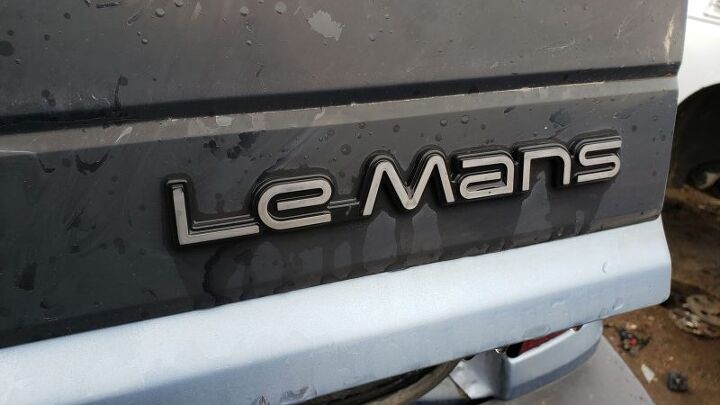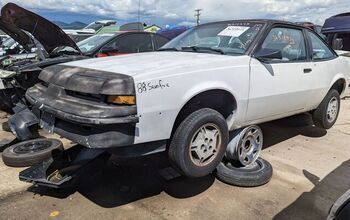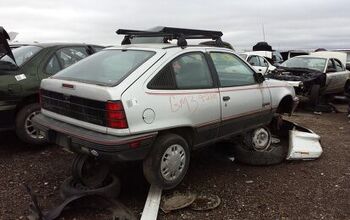Junkyard Find: 1988 Pontiac LeMans Sedan

Since starting doing this goofy car-writing-online gig 13 years ago last month, I have documented the demise of 2,073 discarded vehicles in excruciating detail. During that time, I have walked right past thousands and thousands of allegedly interesting cars and trucks (sorry, BMW 3 Series fans, but I’ve been trying to make it up to you in recent years) in order to obsess over my very favorite kind of junkyard machines: little– known examples of puzzling badge engineering. That means that when I see the South Korean Pontiac LeMans in a junkyard, I photograph it.
Here’s a low-mile, first-model-year LeMans sedan, found in a Denver car graveyard last spring.
The General sold the Daewoo-built Pontiac LeMans in North America for the 1988 through 1993 model years, though it was known as the Asüna SE or GT in Canada for the last part of that period. Prior to that, the LeMans name appeared on a series of rear-wheel-drive midsize Pontiacs from the 1961 through 1981 model years.
The Geo brand (which featured affordable, badge-engineered Isuzus, Suzukis, and Toyotas) might have made sense for this little South Korean car starting in 1989, but it stayed a Pontiac (or Asüna, or Passport) from start to finish. In fact, the Daewoo LeMans was sibling to the Opel Kadett E, so today’s Junkyard Find shares a blood relationship with dozens of car models around the world.
This one came to its final parking space with just barely over 100,000 total miles, and it seems fairly clean and rust-free for a then-31-year-old cheap econobox. As you might expect, any repair costing more than $99.99 serves as a death sentence for the 1988-1993 LeMans, since the depreciation curve for these cars flattened out at scrap levels somewhere around 1998.
The LeMans wasn’t fancy, but its cheap price tag ensured that quite a few 1988-1989 models made it out of dealerships. Today’s ’88 is the sixth Daewoo LeMans I’ve documented en route to The Crusher, after this ’88 hatch, this ’88 sedan, this ’88 hatch, this ’91 hatch, and this ’92 sedan.
This one came with the optional five-speed, auto-reverse cassette deck and even air conditioning, which must have pushed its purchase price well above the $7,925 MSRP (that’s about $17,570 in 2020 dollars). That year, the Toyota Tercel EZ went for a mere $5,948 and the Subaru Justy for only $5,695, but the LeMans was bigger and better-appointed than the poverty-spec versions of those cars. The $5,795 Hyundai Excel, horrid as it was, probably lured away more potential LeMans buyers than any other new car in 1988.
Because I use my influence as Chief Justice of the Lemons Supreme Court to try to induce 24 Hours of Lemons teams to make poor decisions about the cars they race, I have been pushing for a Daewoo LeMans in the series since the early days. Finally, a bunch of Pinto-racing Texans bought a 370k-mile ’89 LeMans AeroCoupe from a spectator at the 2018 Houston race, added badging for all 198 versions of the LeMans sold worldwide, and won Index of Effluency glory at the Colorado race last summer.
Because the Tommy Salami LeMans had the cheapskate four-speed manual, the team wanted a high-performance optional five-speed for added race domination. I found today’s Junkyard Find a few weeks after the race, and a couple of team members drove the seven hours each way from Amarillo in order to harvest its transmission and a bunch of other unobtainium LeMans bits. They sold the car along with the spare parts soon after, in order to make room for a couple of even worse racing ideas. You’ll hear about those later, but I’m sworn to secrecy for now.
The US-market advertising for this car emphasized its cheapness, period, so we’ll hear from a gratifyingly macho-voiced South Korean announcer bragging about the LeMans in its homeland.
If you want to see an additional 2000+ Junkyard Finds, head over to the Junkyard Home of the Murilee Martin Lifestyle Brand™ for links to all of them.

Murilee Martin is the pen name of Phil Greden, a writer who has lived in Minnesota, California, Georgia and (now) Colorado. He has toiled at copywriting, technical writing, junkmail writing, fiction writing and now automotive writing. He has owned many terrible vehicles and some good ones. He spends a great deal of time in self-service junkyards. These days, he writes for publications including Autoweek, Autoblog, Hagerty, The Truth About Cars and Capital One.
More by Murilee Martin
Latest Car Reviews
Read moreLatest Product Reviews
Read moreRecent Comments
- Lichtronamo Watch as the non-us based automakers shift more production to Mexico in the future.
- 28-Cars-Later " Electrek recently dug around in Tesla’s online parts catalog and found that the windshield costs a whopping $1,900 to replace.To be fair, that’s around what a Mercedes S-Class or Rivian windshield costs, but the Tesla’s glass is unique because of its shape. It’s also worth noting that most insurance plans have glass replacement options that can make the repair a low- or zero-cost issue. "Now I understand why my insurance is so high despite no claims for years and about 7,500 annual miles between three cars.
- AMcA My theory is that that when the Big 3 gave away the store to the UAW in the last contract, there was a side deal in which the UAW promised to go after the non-organized transplant plants. Even the UAW understands that if the wage differential gets too high it's gonna kill the golden goose.
- MKizzy Why else does range matter? Because in the EV advocate's dream scenario of a post-ICE future, the average multi-car household will find itself with more EVs in their garages and driveways than places to plug them in or the capacity to charge then all at once without significant electrical upgrades. Unless each vehicle has enough range to allow for multiple days without plugging in, fighting over charging access in multi-EV households will be right up there with finances for causes of domestic strife.
- 28-Cars-Later WSJ blurb in Think or Swim:Workers at Volkswagen's Tennessee factory voted to join the United Auto Workers, marking a historic win for the 89- year-old union that is seeking to expand where it has struggled before, with foreign-owned factories in the South.The vote is a breakthrough for the UAW, whose membership has shrunk by about three-quarters since the 1970s, to less than 400,000 workers last year.UAW leaders have hitched their growth ambitions to organizing nonunion auto factories, many of which are in southern states where the Detroit-based labor group has failed several times and antiunion sentiment abounds."People are ready for change," said Kelcey Smith, 48, who has worked in the VW plant's paint shop for about a year, after leaving his job at an Amazon.com warehouse in town. "We look forward to making history and bringing change throughout the entire South." ...Start the clock on a Chattanooga shutdown.

















































Comments
Join the conversation
I lived in Islamabad from 2011 to 2015 and used to see lots of Daewoo-badged versions of these on the streets. What was funny to me is that they all had the Pontiac arrow-head badge on the grill.
"Pontiac: We Build Excitement". "Pontiac IS Car". And lest we forget the first ever G3..... One more of GM's dumping ground brands with that "something to sell in the segment" corporate taint.